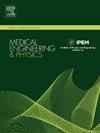Enhanced intravascular lithotripsy (IVL) with ultrasound-shockwave catheter
IF 1.7
4区 医学
Q3 ENGINEERING, BIOMEDICAL
引用次数: 0
Abstract
Intravascular shockwave lithotripsy (IVL) is an effective treatment for vascular calcification. Previous studies suggest that ultrasound can enhance the efficiency of extracorporeal shockwave lithotripsy (ESWL) by mitigating the bubble shielding effect. We developed a novel ultrasound-shockwave catheter that combines flowing liquid and ultrasound to suppress bubble shielding and enhance lithotripsy efficiency. Experimental results confirm the bubble shielding effect in IVL, which can be mitigated by flowing liquid or ultrasound. Fracture experiments using Ultracal-30 as phantoms demonstrate the ultrasound emitted after 10 ms of shockwave generation and combines with bubbles can enhance lithotripsy efficiency. Specifically, the addition of ultrasound and bubbles reduced the mass percentage of fragments larger than 4.5 mm by 38.56 % compared to the control. Spectrum analysis of ultrasound reveals cavitation's role in improving lithotripsy efficiency. In summary, while bubbles initially attenuate shockwave intensity and reduce lithotripsy efficiency, their combination with ultrasound-induced cavitation enhances treatment outcomes.
超声冲击波导管强化血管内碎石术(IVL)
血管内冲击波碎石(IVL)是治疗血管钙化的有效方法。以往的研究表明,超声可以通过减轻气泡屏蔽效应来提高体外冲击波碎石术的效率。我们研制了一种新型的超声冲击波导尿管,该导尿管结合了流动液体和超声来抑制气泡屏蔽,提高碎石效率。实验结果证实了气泡在IVL中的屏蔽作用,这种屏蔽作用可以通过液体流动或超声来缓解。以Ultracal-30为幻象的破裂实验表明,冲击波产生10 ms后发出的超声波与气泡结合可以提高碎石效率。具体来说,与对照组相比,超声波和气泡的加入使大于4.5 mm的碎片质量百分比降低了38.56%。超声波谱分析揭示空化对提高碎石效率的作用。综上所述,虽然气泡最初会减弱冲击波强度并降低碎石效率,但它们与超声诱导空化的结合可以提高治疗效果。
本文章由计算机程序翻译,如有差异,请以英文原文为准。
求助全文
约1分钟内获得全文
求助全文
来源期刊

Medical Engineering & Physics
工程技术-工程:生物医学
CiteScore
4.30
自引率
4.50%
发文量
172
审稿时长
3.0 months
期刊介绍:
Medical Engineering & Physics provides a forum for the publication of the latest developments in biomedical engineering, and reflects the essential multidisciplinary nature of the subject. The journal publishes in-depth critical reviews, scientific papers and technical notes. Our focus encompasses the application of the basic principles of physics and engineering to the development of medical devices and technology, with the ultimate aim of producing improvements in the quality of health care.Topics covered include biomechanics, biomaterials, mechanobiology, rehabilitation engineering, biomedical signal processing and medical device development. Medical Engineering & Physics aims to keep both engineers and clinicians abreast of the latest applications of technology to health care.
 求助内容:
求助内容: 应助结果提醒方式:
应助结果提醒方式:


